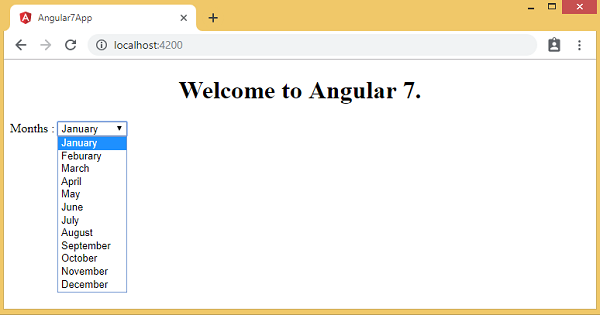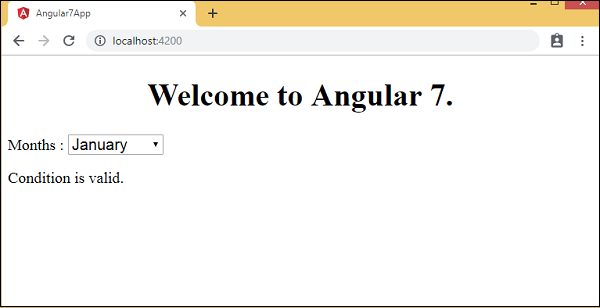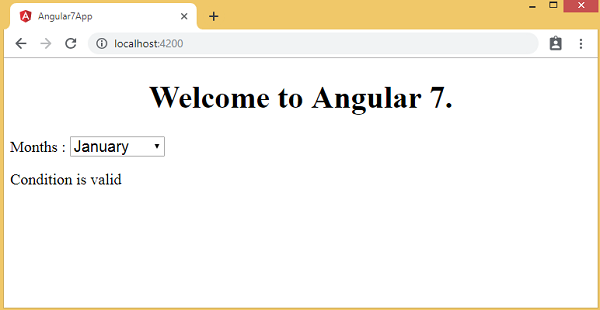Angular7-データバインディング
データバインディングはAngularJSから直接利用でき、Angularのすべてのバージョンは後でリリースされます。データバインディングには中括弧を使用します-{{}}; このプロセスは補間と呼ばれます。前の例で、変数titleに値を宣言する方法をすでに見てきましたが、同じものがブラウザーに出力されます。
の変数 app.component.html ファイルは {{title}} との値 title で初期化されます app.component.ts ファイルと app.component.html、値が表示されます。
ブラウザで月のドロップダウンを作成しましょう。そのために、次の月の配列を作成しましたapp.component.ts 次のように-
import { Component } from '@angular/core';
@Component({
selector: 'app-root',
templateUrl: './app.component.html',
styleUrls: ['./app.component.css']
})
export class AppComponent {
title = 'Angular 7';
// declared array of months.
months = ["January", "February", "March", "April", "May", "June", "July",
"August", "September", "October", "November", "December"];
}上に表示されている月の配列は、ブラウザのドロップダウンに表示されます。
オプション付きの通常の選択タグを作成しました。オプションで、for loop。ザ・for loop は、月の配列を反復処理するために使用されます。これにより、月に存在する値を使用してオプションタグが作成されます。
Angularでの構文は次のとおりです-
*ngFor = “let I of months”そして、それを表示している月の値を取得するために-
{{i}}2つの中括弧は、データバインディングに役立ちます。app.component.tsファイルで変数を宣言すると、中括弧を使用して変数が置き換えられます。
以下は、ブラウザでの上記の月の配列の出力です-

に設定されている変数 app.component.ts 内部でバインドすることができます app.component.html中括弧を使用します。例えば: {{}}。
条件に基づいてブラウザにデータを表示してみましょう。ここでは、変数を追加し、値を次のように割り当てました。true。ifステートメントを使用すると、表示するコンテンツを非表示/表示できます。
例
import { Component } from '@angular/core';
@Component({
selector: 'app-root',
templateUrl: './app.component.html',
styleUrls: ['./app.component.css']
})
export class AppComponent {
title = 'Angular 7';
// declared array of months.
months = ["January", "February", "March", "April", "May", "June", "July",
"August", "September", "October", "November", "December"];
isavailable = true; //variable is set to true
}app.component.html
<!--The content below is only a placeholder and can be replaced.-->
<div style = "text-align:center">
<h1> Welcome to {{title}}. </h1>
</div>
<div> Months :
<select>
<option *ngFor = "let i of months">{{i}}</option>
</select>
</div>
<br/>
<div>
<span *ngIf = "isavailable">Condition is valid.</span>
//over here based on if condition the text condition is valid is displayed.
//If the value of isavailable is set to false it will not display the text.
</div>出力

上記の例を使用して説明しましょう IF THEN ELSE 状態。
例
import { Component } from '@angular/core';
@Component({
selector: 'app-root',
templateUrl: './app.component.html',
styleUrls: ['./app.component.css']
})
export class AppComponent {
title = 'Angular 7';
// declared array of months.
months = ["January", "Feburary", "March", "April", "May","June", "July",
"August", "September", "October", "November", "December"];
isavailable = false; //variable is set to true
}この場合、私たちは isavailablefalseとして変数。印刷するにはelse 条件、作成する必要があります ng-template 次のように-
<ng-template #condition1>Condition is invalid</ng-template>完全なコードを以下に示します-
<!--The content below is only a placeholder and can be replaced.-->
<div style = "text-align:center">
<h1> Welcome to {{title}}. </h1>
</div>
<div> Months :
<select>
<option *ngFor = "let i of months">{{i}}</option>
</select>
</div>
<br/>
<div>
<span *ngIf = "isavailable; else condition1">Condition is valid.</span>
<ng-template #condition1>Condition is invalid</ng-template>
</div>else条件で使用され、使用される変数が condition1。同じが割り当てられますid に ng-template、および使用可能な変数がfalseに設定されている場合、テキスト Condition is invalid 表示されています。
次のスクリーンショットは、ブラウザでの表示を示しています-

今使用しましょう if then else 状態。
import { Component } from '@angular/core';
@Component({
selector: 'app-root',
templateUrl: './app.component.html',
styleUrls: ['./app.component.css']
})
export class AppComponent {
title = 'Angular 7';
// declared array of months.
months = ["January", "February", "March", "April", "May", "June", "July",
"August", "September", "October", "November", "December"];
isavailable = true; //variable is set to true
}次に、変数を作成します isavailable本当のように。HTMLでは、条件は次のように記述されます-
<!--The content below is only a placeholder and can be replaced.-->
<div style = "text-align:center">
<h1> Welcome to {{title}}. </h1>
</div>
<div> Months :
<select>
<option *ngFor="let i of months">{{i}}</option>
</select>
</div>
<br/>
<div>
<span *ngIf = "isavailable; then condition1 else condition2">
Condition is valid.
</span>
<ng-template #condition1>Condition is valid</ng-template>
<ng-template #condition2>Condition is invalid</ng-template>
</div>変数がtrueの場合、 condition1、 そうしないと condition2。これで、2つのテンプレートがidで作成されます#condition1 そして #condition2。
ブラウザでの表示は以下のとおりです。
